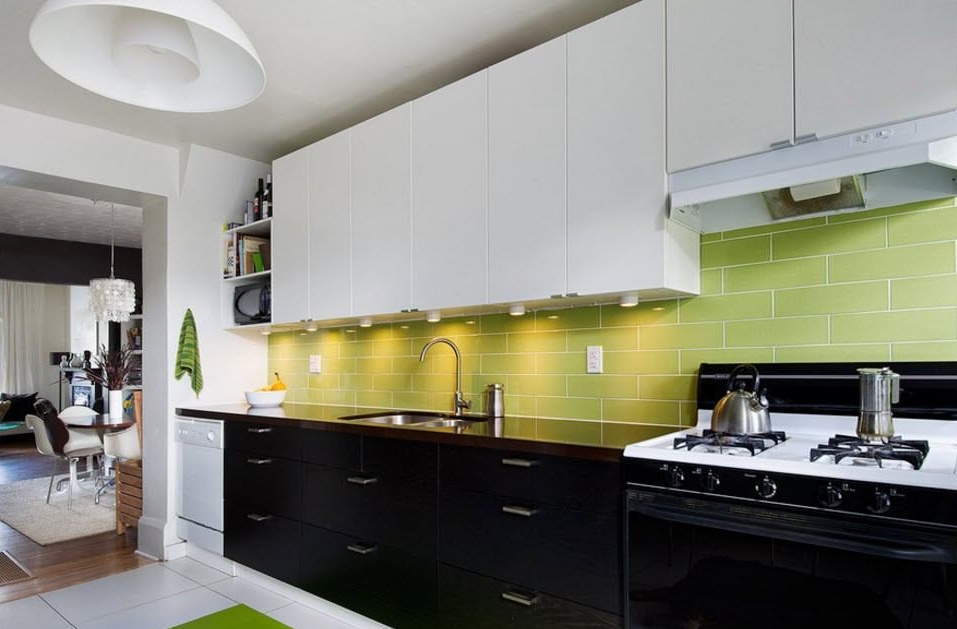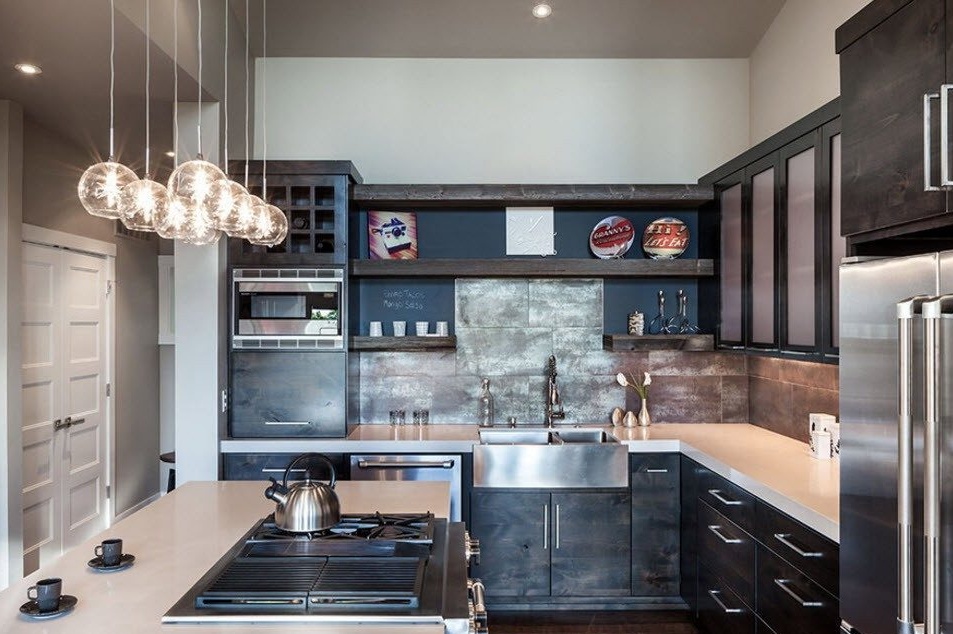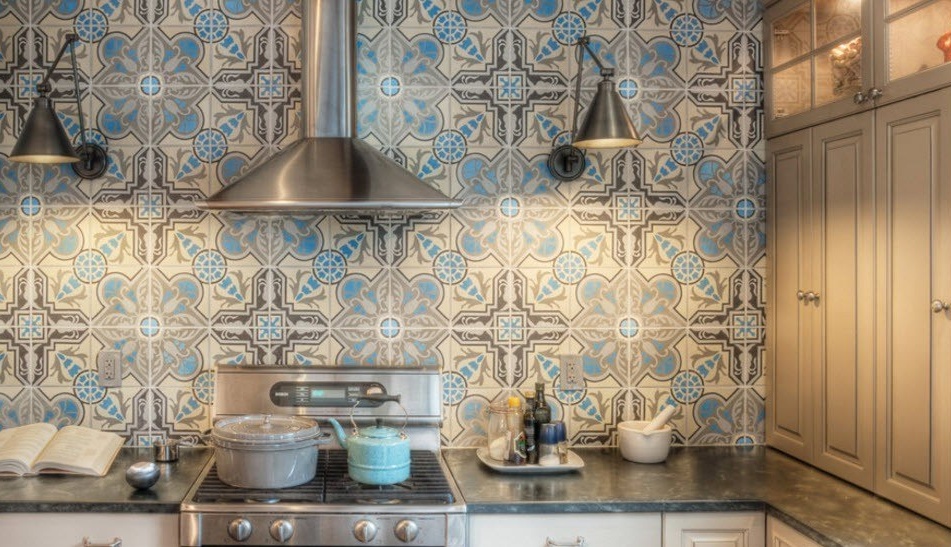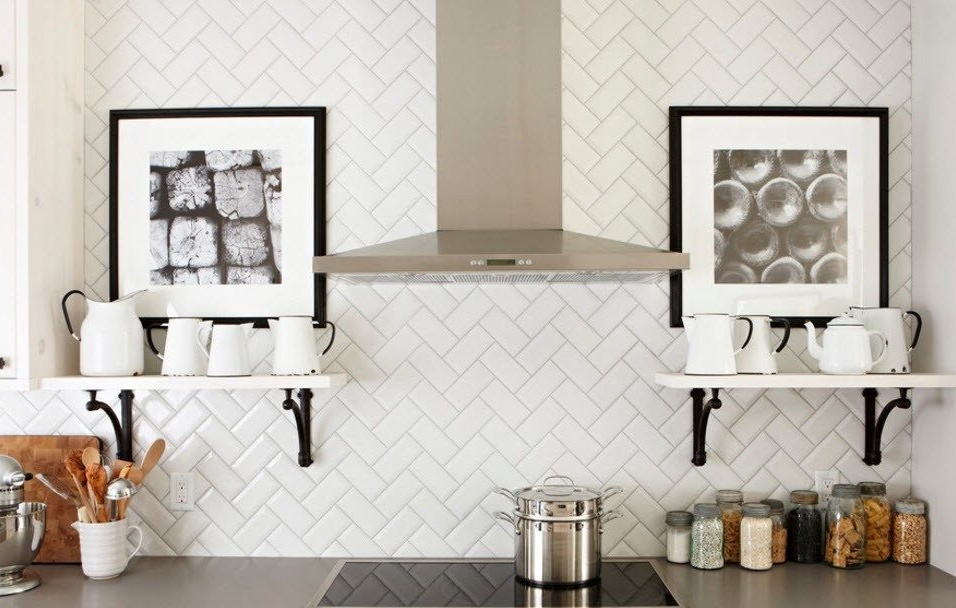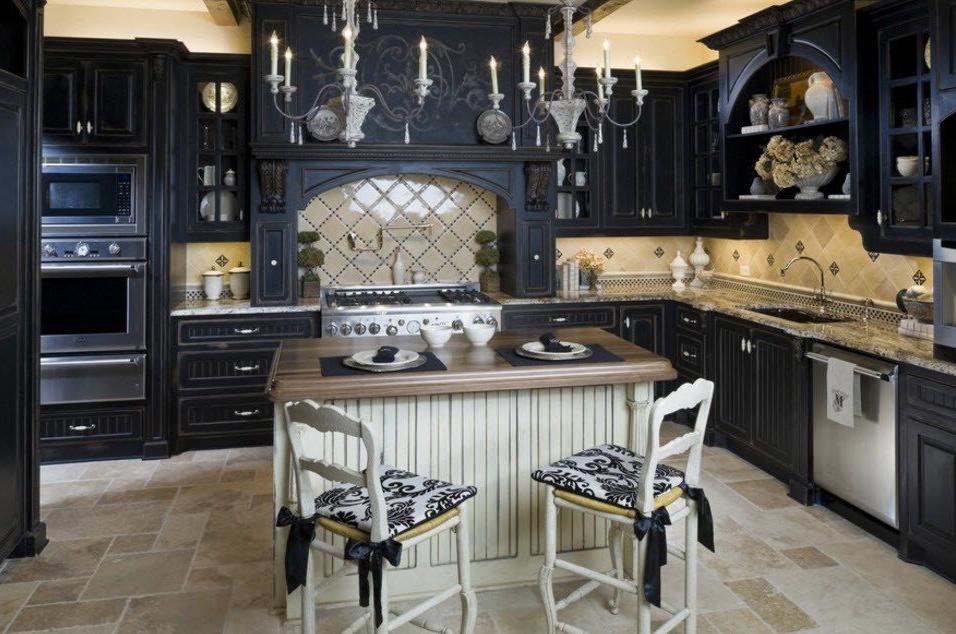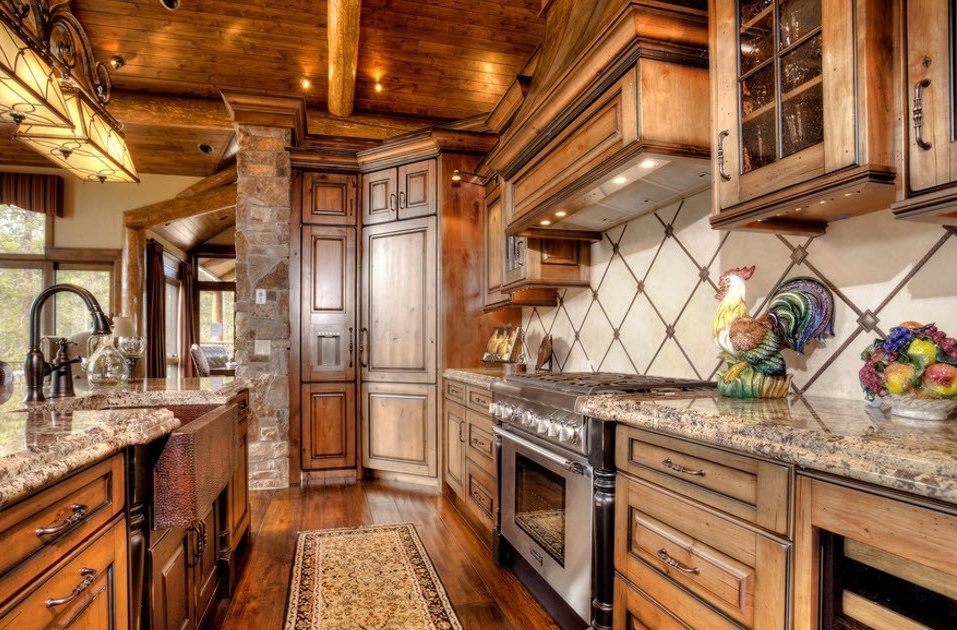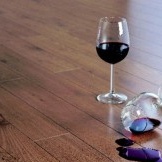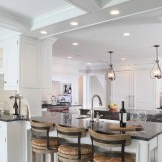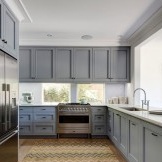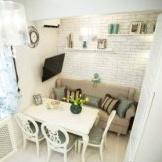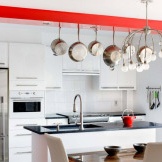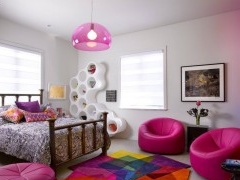Tiles for the kitchen - choose the best
Rarely does a modern kitchen design dispense with the use of ceramic or stone tiles. It is difficult to imagine a more practical and aesthetic coating for a kitchen apron. For some kitchen design styles, the use of ceramics is characteristic not only for lining the surface between countertops and the upper tier of kitchen cabinets, but also for floors and even walls completely. To provide reliable protection for kitchen surfaces from moisture and temperature changes, but at the same time not to turn the room into a bathroom or a bathroom, having stood stylistic, color and texture combinations, it is necessary to approach the choice of ceramic or stone tiles with extreme care.
Advantages of ceramic tiles for facing kitchen surfaces:
- high resistance to moisture;
- heat resistance, resistance to temperature extremes;
- ease of care and the ability to use chemical cleaning products;
- resistance to direct sunlight;
- durability with careful handling;
- a rich palette of flowers, ornaments, drawings;
- the ability to simulate stone, wood and glass surfaces, glossy and matte finish.
But, like any facing material, tiles have disadvantages:
- rather high cost in comparison with wallpaper, painting and wall panels;
- the impossibility of self-assembly without the possession of certain skills, which means that the cost of the material itself will need to add payment to the facing specialists;
- lining process - quite dirty work;
- if you change your mind after a couple of years or the color of the tile gets tired, changing the lining will not be easy.
Useful tips for choosing ceramic tiles
1.One of the main rules for successfully buying finishing materials is to go shopping only after you finally decide on the design of the room. If the style of the interior, the color and texture of the facades of the kitchen, the decoration of other surfaces, except for the apron or other planes that will be tiled, are defined, then you can proceed to the next step. Do not forget with the choice of material and color of the countertop, its combination with the material of the kitchen apron will have considerable weight in the entire image of the kitchen. Decide - do you want the apron to act as a contrast to the countertops and facades of the kitchen furniture ensemble, or to support the overall color scheme?
 2. When choosing a design for the future kitchen, be sure to make a plan (collage) - on paper or in electronic form. On the Internet it is not difficult to find photos of any options for kitchen cabinets, tables, chairs, lighting fixtures and other kitchen accessories. Look at the combination of the colors of the furniture and the floor, the decoration of the walls and the apron, and maybe in the process you decide that the area of the tiling can be extended to other surfaces. It is better to know about this in advance, before calculating the required amount of material. If you use material with a pattern for decoration, then you can not do without a visual image.
2. When choosing a design for the future kitchen, be sure to make a plan (collage) - on paper or in electronic form. On the Internet it is not difficult to find photos of any options for kitchen cabinets, tables, chairs, lighting fixtures and other kitchen accessories. Look at the combination of the colors of the furniture and the floor, the decoration of the walls and the apron, and maybe in the process you decide that the area of the tiling can be extended to other surfaces. It is better to know about this in advance, before calculating the required amount of material. If you use material with a pattern for decoration, then you can not do without a visual image.
 3. Never buy tiles called end-to-end. Of course, this material is not cheap, and some collections are very expensive, but saving, you can do yourself a disservice. It is no accident that designers and finishing specialists recommend adding at least 10% to the estimated number of materials. This stock is necessary in case of an accidental battle, measurement errors. It will be difficult to buy exactly the same tile if the store has run out of “your” party - the hue and even texture may differ.
3. Never buy tiles called end-to-end. Of course, this material is not cheap, and some collections are very expensive, but saving, you can do yourself a disservice. It is no accident that designers and finishing specialists recommend adding at least 10% to the estimated number of materials. This stock is necessary in case of an accidental battle, measurement errors. It will be difficult to buy exactly the same tile if the store has run out of “your” party - the hue and even texture may differ.
 4. In order not to make mistakes in calculating the required amount of material, then not to stay with extra bundles that the store is not going to take back, do not fully trust the consultants in the store. An experienced seller and his consultation are excellent help in the calculations, but not the ultimate truth. If the seller made a mistake. It will not be easy to prove later, and the store is unlikely to accept extra tiles back.
4. In order not to make mistakes in calculating the required amount of material, then not to stay with extra bundles that the store is not going to take back, do not fully trust the consultants in the store. An experienced seller and his consultation are excellent help in the calculations, but not the ultimate truth. If the seller made a mistake. It will not be easy to prove later, and the store is unlikely to accept extra tiles back.
 5. If decors, friezes and borders will be used in your cladding, try to come up with several options for composition. So you can not only come up with a new apron design, but also make more accurate calculations of the necessary material.
5. If decors, friezes and borders will be used in your cladding, try to come up with several options for composition. So you can not only come up with a new apron design, but also make more accurate calculations of the necessary material.
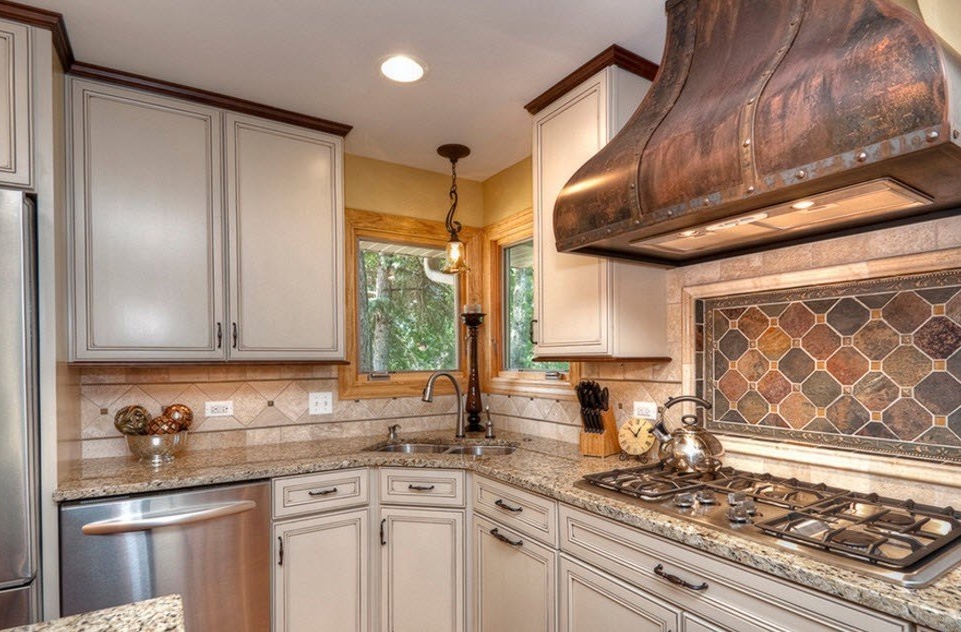 6. Carefully inspect the entire tile when buying. If, after accepting the goods, you sign the relevant delivery documents, then there will be no one to make claims regarding the quality of the tiles.
6. Carefully inspect the entire tile when buying. If, after accepting the goods, you sign the relevant delivery documents, then there will be no one to make claims regarding the quality of the tiles.
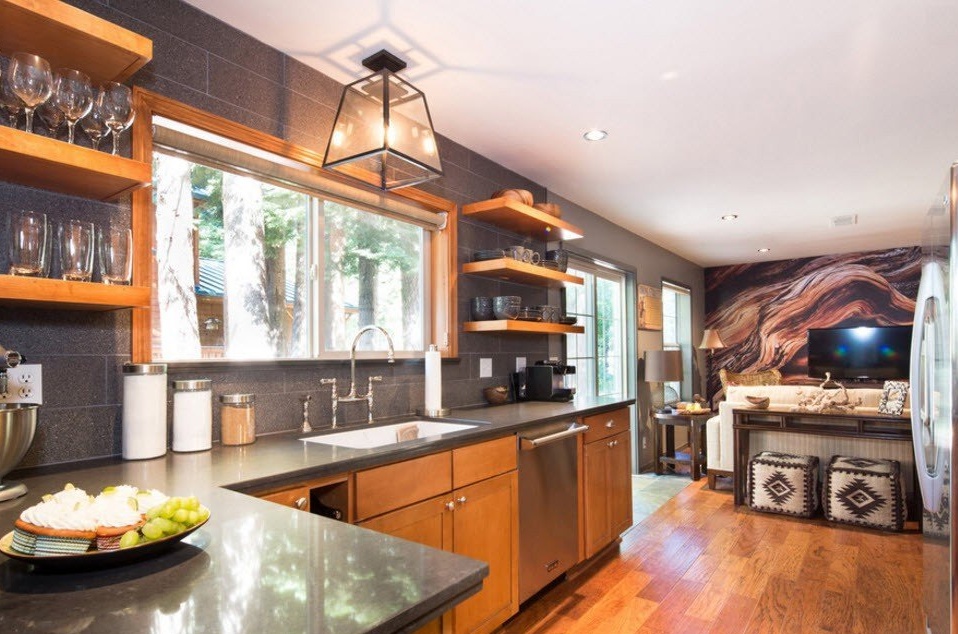 7. Do not take the first tile size that you like by design. Regardless of which surface the material is purchased for, an incorrectly selected product size can ruin the whole impression. If the tiles in height or width do not fit into the frames of the kitchen apron or do not fit into the floor area - they will have to be cut, pick up a picture (if there is one). And in the end, you will spend more money, time and effort on a surface that might not be a hassle.
7. Do not take the first tile size that you like by design. Regardless of which surface the material is purchased for, an incorrectly selected product size can ruin the whole impression. If the tiles in height or width do not fit into the frames of the kitchen apron or do not fit into the floor area - they will have to be cut, pick up a picture (if there is one). And in the end, you will spend more money, time and effort on a surface that might not be a hassle.
 8. When measuring walls - be sure to apply the tape measure in a straight line. Check the shape and size of the sides of the kitchen. It is enough to measure the diagonals of the room - if they are equal, then the angles of your kitchen are ninety degrees and there is nothing to worry about.
8. When measuring walls - be sure to apply the tape measure in a straight line. Check the shape and size of the sides of the kitchen. It is enough to measure the diagonals of the room - if they are equal, then the angles of your kitchen are ninety degrees and there is nothing to worry about.
 9. Obviously, when choosing a tile for any room, we first of all look at the design of the product - a combination of colors, ornament, texture. But it is important not to forget about the technical characteristics of the finishing material. So that your facing will serve you faithfully for many years, please the eye and not cause trouble, try to choose a tile with special protection from exposure to chemicals. A kitchen apron is a zone of increased pollution; not only water, but also hot oil and fat gets on its surface. Surely in the future, you will use cleaning products to care for this area and it is better that your tile is ready for such actions. Tiles with antibacterial effect are marked AA.
9. Obviously, when choosing a tile for any room, we first of all look at the design of the product - a combination of colors, ornament, texture. But it is important not to forget about the technical characteristics of the finishing material. So that your facing will serve you faithfully for many years, please the eye and not cause trouble, try to choose a tile with special protection from exposure to chemicals. A kitchen apron is a zone of increased pollution; not only water, but also hot oil and fat gets on its surface. Surely in the future, you will use cleaning products to care for this area and it is better that your tile is ready for such actions. Tiles with antibacterial effect are marked AA.
 10. When choosing a tile for flooring, pay attention to the properties of wear resistance (experts recommend purchasing third-class products on a PEI scale). It is also important to consider the possibility of sliding the surface of the floor tiles - the coefficient of friction should be in the range from 0.5 to 0.8. If you manage to purchase tiles with a coefficient greater than 0.75 - you will not regret the purchase for many years. Make sure that the surface of the floor tile is not porous - dirt will be very poorly cleaned from the pores.
10. When choosing a tile for flooring, pay attention to the properties of wear resistance (experts recommend purchasing third-class products on a PEI scale). It is also important to consider the possibility of sliding the surface of the floor tiles - the coefficient of friction should be in the range from 0.5 to 0.8. If you manage to purchase tiles with a coefficient greater than 0.75 - you will not regret the purchase for many years. Make sure that the surface of the floor tile is not porous - dirt will be very poorly cleaned from the pores.
The color palette is the key to success in decorating the kitchen
Operational characteristics, sizes and even the price of the material are of most interest to us in the second place, the first thing we pay attention to is product design. The choice of color for ceramic tiles, which will become the lining of the kitchen apron, is not an easy task. First of all, you need to decide - what do you want from your finish? Should the apron stand out in the overall aesthetics of the kitchen room or is the furniture set dedicated to this role? Do you choose a calm color scheme or want bright accents, because it is the apron that can become the main focal point of your kitchen.
The gentle, calm tone of the ceramic tiles harmonizes with the entire palette of the kitchen. Glossy tiles resonate with the sheen of stainless steel appliances and the almost mirrored surface of the peninsula's countertops. The result was a calm image of the kitchen in natural colors, but not without the brilliance of modernity and a special charm.
For a black and white design of a kitchen set, a bright apron can become a spectacular intermediary. The saturated color of ceramic tiles will not only bring diversity to the room’s palette, but will also increase the degree of the whole image and bring festive notes.
A bright apron combined with a bright kitchen set is a win-win option. This is especially true for small rooms where light surfaces must be used to visually increase the space, and bright accents are responsible for the diversity of the palette and bringing positive into the bright image of the kitchen.
The combination of green shades in ceramic lining with natural, bright tones of the kitchen facades creates an excellent mood. In such a kitchen, it is always spring, a holiday and a positive attitude.
Tiles with imitation marble coating will give even a small kitchen a touch of luxury and elegance, and in a spacious room with a traditional suite will look more than organic.
The metallic coating of the tile with a slight sheen and even patina will organically look in the modern style of the kitchen design. Such an apron will be perfectly combined with household appliances and the brilliance of lighting fixtures.
White apron - timeless classic
The popularity of white ceramic tiles "metro", probably, will never pass. Classic kitchens in the Provence style, retro, vintage, country and shabby chic, in the Scandinavian style or even minimalism - it is difficult to imagine a style in which such a finish could not fit organically. Matte and glossy, with bevels around the perimeter and without - the “metro” tile is suitable for those who vote against experiments in the interior of the kitchen, considering this room a symbol of traditional dwelling.
White tile "metro" in combination with dark grout will give some structurality to the interior, emphasize the geometry of the kitchen.
Snow-white kitchens will never go out of fashion - many of us want to see the cooking room not only clean and bright, but also light, almost airy. A white kitchen set and an apron of a similar color are only slightly diluted with the sheen of household appliances and the natural shades of wooden countertops.
Drawings and ornaments - a highlight of the kitchen interior
Colorful ornaments on ceramic tiles look great in kitchen spaces with bright, plain furniture. Speaking in contrast, bright tiles not only become the focal point of the kitchen, but also emphasizes the severity of the lines of the concise color palette of the kitchen set.
Facing an entire wall with colorful tiles is a design move that is not suitable for every kitchen. In a small room, it is better to refrain from such a finish and give preference to monophonic, neutral options. In a spacious kitchen, this technique can be justified when using ceramics in the drawing no more than two contrasting colors and their shades, especially if they are already present in the interior design.
A motley apron, made in the style of patchwork, will organically look only with plain furniture and preferably in bright colors.
Kitchen design options with ceramic tiles
By placing the tile horizontally in the finish of the apron, you visually increase the space of the room, lining the same surface with a vertical arrangement of products - you will achieve a visual increase in the height of the room.
An interesting visual impression is the laying of the Christmas tree tiles according to the type of parquet flooring. The original design may require more material, but it will organically transform even the most trivial kitchen interior.
Textured tile for a kitchen apron - an infrequently used option. For obvious reasons, such a surface will be more difficult to clean, and it will have to be done more often than usual, but the visual effect produced by the unusual coating covers all the time and physical costs of caring for the apron.
If the sink in the kitchen is located near the window, then the space of ceramic tile lining can be extended to the ceiling, not limited to the distance from the working surfaces to the window. Given that the window occupies most of the wall, the abundance of ceramic finishes will not be evident, and you will be spared the associations of decorating space with a bathroom.
Using a combination of ceramic tiles and mosaics in the decoration of the kitchen apron, you can achieve interesting images. If you need to hide surface imperfections or to cover a plane with rounding, niches, then mosaic tiles will cope with this task like no other material.
The diagonal arrangement of the tile contributes to the visual expansion of the space. This technique will be especially relevant when using a kitchen set in dark color.
The figured tile in the lining of the kitchen apron looks more than impressive. Especially when using a contrasting grout color to highlight the contours of the original form.
Another original way to protect surfaces near work areas from moisture and high temperature is by facing with ceramics. Imitation wood or stone tiles in the shape of a honeycomb. The material consumption will be small, and you can always add products if you see that the zone of exposure to moisture, hot fat and other troubles turned out to be more than expected.
Ceramic cladding imitating a brick wall will organically look in the kitchens made in the style of loft, minimalism, modern style, country and Provas.
Tile as flooring
Many homeowners prefer not to dwell on the use of ceramics for lining a kitchen apron and use tiles to finish the floors. This is a very practical, albeit expensive, option for flooring. All the advantages of ceramic tiles used for vertical surfaces can be safely transferred to floor products. And in the case of using porcelain stoneware, we get an even more durable and durable flooring.
As mentioned above, the usual criteria for choosing tiles for flooring are added to the properties of wear resistance and lack of sliding, because in addition to aesthetics and performance, safety of decoration is important to us. Clinker tiles can become an original and practical choice of flooring in the kitchen space - hardened in a special way at high temperature, it is a strong, easy to use and durable material for facing. The characteristic color of clinker products will look great in a kitchen made in the style of country, Provence or retro. But for modern areas of design of kitchen facilities, such a coating can be a highlight of the interior.
An interesting design move that will help to make the interior of your kitchen unique is to use porcelain stoneware similar in color to the lining of the kitchen apron for decorating floors. A practical, but at the same time original way of finishing the kitchen space can become the main feature of the interior.
Another way to diversify the interior with the help of combinatorics of tiled flooring and apron is the use of a contrasting black and white combination. For example, a white tile with a dark grout is used to finish the apron, and an almost black cladding with a snow-white grout is used as a flooring. Of course, with such a coloring, tile joints on the floor will have to pay more attention during cleaning, but the appearance of the kitchen is worth it.









